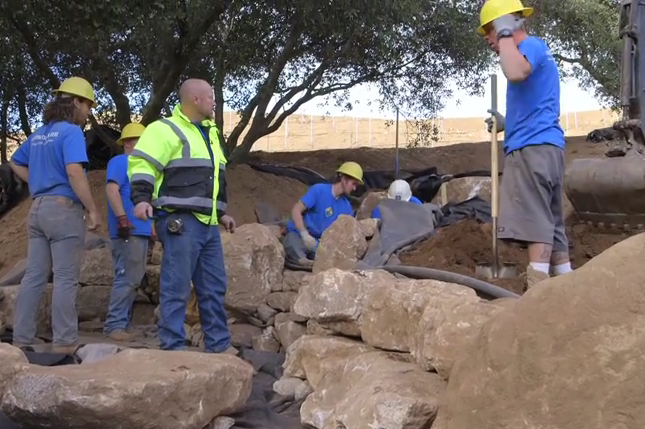Rocky Road

Maybe it has something to do with the fact that I can sometimes look like a rock outcropping myself: Whatever it is, I love working with big chunks of stone in my pond projects. More than any single design element I can deploy, there is no other component that’s more important when it comes to making my work look as though it’s been there forever.
In the project covered in this video series, the scale and scope of our work was grand enough that I had the opportunity to work with some very large boulders, including many in the heavy, 36-inch range. This meant that everything in the vigorous watercourse was upsized, including larger gravel and bigger plants as well as substantial terraces, cascades, falls and pools to match.
As I point out in the video, we had the big advantage in this case of sourcing all of our larger material right on site. I can’t think of a better boost in the natural-appearance department: Not only does the material look like it belongs – it actually does belong, as can be witnessed in even a brief walk through the surrounding landscape.
This leads me to a general point I don’t think I’ve made before with any other video: I’m always out hiking in my local area, looking for rock formations and water flows that inspire what I do with my ponds, streams and waterfalls. I know this is a practice that countless watershapers who work on the natural side of things do to bring authenticity to their designs. This is why I’m always telling my crews to put on their boots and get moving: Not only is it good exercise, but it makes our on-site work flow more easily as well.
Importantly, this video also shows how we work with the liner and underlayment as our edges take shape. I stress in brief how critical it is to pad big rocks and give yourself adequate material at the margins of the watershape – and I want to drive that point home here: As mentioned in a previous entry in this series, water will travel in unexpected ways, so we make a point of working our terraces in such a way that our liner edges are protected and reach well above what we anticipate will be the operating water level.
It takes care, caution and foresight, but I prefer to play it on the safe side where water is concerned.
To see how lucky we were with our on-site rock supply, click here.
Eric Triplett is founder and chief executive officer at The Pond Digger Waterscape Design & Construction in Yucaipa, Calif. He may be reached at eric@the ponddigger.com.










